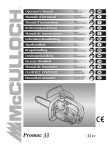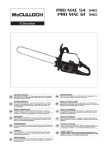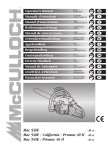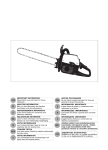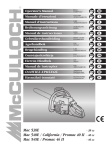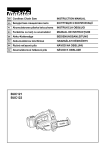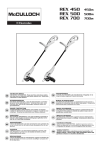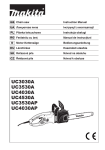Download McCulloch M DAHT25 Operator`s manual
Transcript
GB EC Declaration of Conformity The undersigned, authorised by H.O.P.I., declares that the petrol-driven chainsaw TH 33, manufactured by H.O.P.I., 23868 Valmadrera (LC), Via Como 72, Italy, is in accordance with the European Directives 98/37/CEE (Machinery Directive), 73/23/EEC (Low Voltage Directive), 93/68/CEE (CE Marking Directive) & 89/336/CEE (Directive on electromagnetic compatibility). Directive 2000/14/ECC (Annex V). DE CE Konformitätserklärung Der Unterzeichnete, bevollmächtigt durch H.O.P.I., erklärt, daß die Kettensägen mit Benzinmotor TH 33, hergestellt durch H.O.P.I., 23868 Valmadrera (LC), Via Como 72, Italy, den Europäischen Richtlinien 98/37/CEE (Maschinenrichtlinie), 73/23/EEC (Niederspannungsdirektive), 93/68/CEE (CE Kennzeichnungsrichtlinie) & 89/336/CEE (EMV Richtlinie) entspricht. Richtlinie 2000/14/ECC (Anhang V). FR Déclaration de conformité Européenne Le soussigné, dûment mandaté par H.O.P.I., déclare que les tronçonneuses thermiques TH 33, fabriqué par H.O.P.I., 23868 Valmadrera (LC), Via Como 72, Italy, est conforme aux Directives Européennes 98/37/CEE (Directive Sécurité Machine), 73/23/EEC (Directive Basse Tension), 93/68/CEE (Directive Marquage CE) & 89/336/CEE (Directive EMC). Directive 2000/14/ECC (Annexe V). NL EG Conformiteitsverklaring Ondergetekende, gemachtigd door H.O.P.I., verklaart dat de benzine aangedreven kettingzaag TH 33, geproduceerd door H.O.P.I., 23868 Valmadrera (LC), Via Como 72, Italy voldoet aan de Europese Richtlijnen 98/37/CEE (Machinerie Richtlijn), 73/23/EEC (Matala jännite-direktiivi), 93/68/CEE (EG Markering Richtlijn) & 89/336/CEE (Richtlijn aangaande elektromagnetische compatibiliteit). Richtlijn 2000/14/ECC (Annex V). NO EF Erklæring om Overensstemmelse Undertegnede, autorisert av H.O.P.I., erklærer at bensindrevne kjedesager TH 33, produsert av H.O.P.I., 23868 Valmadrera (LC), Via Como 72, Italy, er i overensstemmelse med følgende europeiske direktiver: 98/37/CEE (Maskindirektiv), 73/23/EEC (Direktiv for lavspenning), 93/68/CEE (CE-merkingsdirektiv) & 89/336/CEE (Direktiv om elektromagnetisk kompatibilitet). Direktiv 2000/14/ECC (Annex V). FI DK EU Overensstemmelse-erklæring Undertegnede, bemyndiget af H.O.P.I., erklærer herved, at benzindrevne kædesave TH 33, H.O.P.I., 23868 Valmadrera (LC), Via Como 72, Italy, er i overensstemmelse med de eurpæiske direktiver 98/37/CEE (Maskineri direktiv), 73/23/EEC (Direktiv for lavspænding), 93/68/CEE (CE mærkningsdirektiv) & 89/336/CEE (EMC-direktiv). Direktiv 2000/14/ECC (Annex V). ES C. B. D. Declaracion de cumplimiento de la directriz de la UE El abajo firmante, autorizado por H.O.P.I., afirma que las motosierras de gasolina TH 33, fabricado por H.O.P.I., 23868 Valmadrera (LC), Via Como 72, Italy, cumple con las directivas Europeas 98/37/CEE (Directiva sobre Maquinaria), 73/23/EEC (Directiva sobre Bajo Voltaje), 93/68/CEE (Directiva sobre Marcas de la CE) & 89/336/CEE (Directiva sobre ‘Compatibilidad Electro Magnetica’). Directiva 2000/14/ECC (Anexo V). PT Declaração de Conformidade CE O abaixo assinado, autorizado por H.O.P.I., declara que as serras mecänícas a gasolina TH 33, fabricada por H.O.P.I., 23868 Valmadrera (LC), Via Como 72, Italy, estão de acordo com as Directivas Europeias 98/37/CEE Directiva de Maquinaria), 73/23/EEC (Directiva sobre Baixas Tensões), 93/68/CEE (Directiva de Marcação CE) e 89/336/CEE (Directiva de Compatibilidade Electromagnética). Directiva 2000/14/ECC (Apêndice V). IT Dichiarazione di Conformità CE Il sottoscritto, autorizzato dalla H.O.P.I., dichiara che la sega a catena portatile da legno TH 33, costruito dalla H.O.P.I., 23868 Valmadrera (LC), Via Como 72, Italia, è conforme alle Direttive Europee: 98/37/CEE (Direttiva Macchine), 73/23/EEC (Direttiva Bassa Tensione), 93/68/CEE (Direttiva Marcatura CEE) & 89/336/CEE (Direttiva Compatibilità Elettromagnetica). Direttiva 2000/14/ECC (Allegato V). GR ∆ήλωση Συµµρφωσης προς τις Eντολές της EE O υπογεγραµµένος, µε eξουσιοδτηση της H.O.P.I., δηλωνω τι: τα βενζινοκίνητα αλυσοπρίονα TH 33, κατασκευασθέντα απ την H.O.P.I., 23868 Valmadrera (LC), Via Como 72, Italy, ανταποκρίνονται προς τις Eυρωπαϊκές Eντολές, 73/23/CEE Oδηγία χµηλής Tάσης (ασφάλεια), 98/37/CEE (η περί Mηχανηµάτων Eντολή), 93/68/CEE (η περί του Σήµατος CE Eντολή) & 89/336/CEE (η περί Hλεκτροµαγνητικής Συµβαττητας Eντολή). Kαvοvιδµς 2000/14/ECC (V). EU Julistus Vastaavuudesta Allekirjoittanut, H.O.P.I. in valtuttaamana, vakuuttaa että bensiinimoottorisahat TH 33, ja jotka on valmistanut H.O.P.I., 23868 Valmadrera (LC), Via Como 72, Italy, on Euroopan direktiivien 98/37/CEE (Koneisto-direktiivi), 73/23/EEC (Matala jännite-direktiivi), 93/68/CEE (CE Merkintä-direktiivi) & 89/336/CEE (Elektromagneettinen Yhteensopivuus-direktiivi) mukainen. Direktiivi 2000/14/ECC (Liite V). A. HU EC nyilatkozat Alulírott, a H.O.P.I. által meghatalmazott ezennel kijelenti, hogy a benzinmotoros láncfúrész TH 33, amelyet a H.O.P.I., 23868 Valmadrera (LC), Via Como 72, Italy gyárt, megfelelnek a 98/37/CEE európai irányelvnek (gépi berendezések irányelv), a 73/23/ EEC, a 93/68/CEE európai irányelvnek (CE-irányelv) és a 89/336/CEE (az elektromágneses kompatibilitásra vonatkozó irányelv). Direktíva 2000/14/ECC (Melléklet V). SE EC Declaration of Conformity Undertecknad, auktoriserad av H.O.P.I., försäkrar att bensindrivna kedjesågar TH 33, tillverkade av H.O.P.I., 23868 Valmadrera (LC), Via Como 72, Italy, är i överensstämmelse med följande europeiska direktiv 98/37/CEE (Maskindirektiv), 73/23/EEC (Lågspänningsdirektiv), 93/68/CEE (CE-märkningsdirektiv) & 89/336/CEE (Elektromagnetisk kompatibilitet). Direktiv 2000/14/ECC (Annex V). 50 : 1 McCulloch or totally synthetic 2T oil 40 : 1 2% 20 cm3 2,5% 25 cm3 4 80 100 5 100 125 10 200 250 20 400 500 Partner oil Husqvarna Outdoor Products Italia S.p.A. Via Como 72 23868 Valmadrera (LC) ITALY Phone + 39 0341 203111 - Fax +39 0341 581671 PN. 248580 (04/06) Valmadrera, 15.12.01 Giuseppe Todero (Direttore Tecnico) H.O.P.I. 1 ltr. E. H. 12” 300mm 45T 3/8” GB 242151B 852312B 214215B (5/32”) Due to a constant product improvement programme, the factory reserves the right to modify technical details mentioned in this manual without prior notice. DE Im Sinne des Fortschritts behält sich der Hersteller das Recht vor, technische @ Änderungen ohne vorherigen Hinweis durchzuführen. F. G. I. L. FR La Maison se réserve la possibilité de changer des caractéristiques et des données de ce manuel à n’importe quel moment et sans préavis. NL Door konstante produkt ontwikkeling behoud de fabrikant zich het recht voor om rechnische specificaties zoals vermeld in deze handleiding te veranderen zonder biervan vooraf bericht te geven. NO Produsenten forbeholder seg all rett og mulighet til å forandre tekniske detaljer i denne manualen uten forhåndsvarsel. FI Jatkuvan tuotteen parannusohjelman tähden valmistaja pidättää oikeuden vaihtaa ilman ennakkovaroitusta tässä ohjekirjasessa mainittuja teknisiä yksityiskohtia. SE Tilverkaren reserverar sig rätten att ändra fakta och uppgifter ur handboken utan förvarning. DK Producenten forbeholder sig ret til ændringer, hvad angår karakteristika og data i nærværende instruktion, når som helst og uden varsel. ES La firma productora se reserva la posibilidad de cambiar las características y datos del presente manual en cualquier momento y sin previo aviso. PT A casa productora se reserva a possibilidade de variar características e dados do presente manual em qualquer momento e sen aviso prévio. IT La casa produttrice si riserva la possibilità di variare caratteristiche e dati del presente manuale in qualunque momento e senza preavviso. GR HU Λγω προγράµµατος συνεχούς βελτίωσης προϊντων, το εργοστάσιο επιφυλάσσεται του δικαιώµατος να τροποποιεί τις τεχνικές λεπτοµέρειες που αναφέρονται στο εγχειρίδιο αυτ χωρίς προηγούµενη ειδοποίηση. Folyamatos gyártmány felùjítási müsorunk következtében, a gyártó cég fenntartja a jogát ebben a Használati leirt müszaki adatok elözetes értesítés nélküli változtatására. A. General description 1 - BAR 2 - CHAIN 3 - FUEL TANK CAP 4 - OIL TANK CAP 5 - STOP SWITCH 6 - STARTER HOUSING 7 - STARTER HANDLE 8 - FRONT HANDLE 9 - AIR FILTER COVER 10 - CHOKE KNOB 11 - CARBURETOR ADJUSTMENT SCREWS 12 13 14 15 16 17 18 19 20 21 22 - SAFETY CHAIN BRAKE - BAR RETAINING NUTS - CHAIN CATCHER - MUFFLER SHIELD - REAR HANDLE - THROTTLE TRIGGER LOCKOUT - THROTTLE TRIGGER - CHAIN BRAKE COVER - CHAIN ADJUSTER SCREW / INTENZ - SPIKE/SPACER - THROTTLE ADVANCE Safety precautions If not used properly this chainsaw can be dangerous. The warnings and safety instructions must be followed to ensure reasonable safety and efficiency in using this product. The operator is responsible for following the warnings and instructions in this manual and on the product. Explanation of Symbols Always have a first aid kit nearby Read operator’s manual carefully Wear safety clothing: Approved safety glasses or face shield Noise emission to the environment according to the European Community’s Directive. Approved safety helmet This product is in accordance with applicable EC directives. Approved ear defender Do not smoke while refuelling or while operating the machine Approved gloves Approved safety footwear Warning - Caution Choke fully opened (hot start /run) ENGLISH - 1r Choke partially opened Regular cleaning is required Choke closed (cold start) Do not cut with the end on the bar, this may cause kickback Visual check Never use the machine with only one hand Switch off the engine by moving the stop switch to the STOP position before carrying out any checks or maintenance. Special Training is required to service and repair chain saws Brake engaged / disengaged Always use the machine with both hands Beware of kickback B. Safety precautions 1 All operators should read this manual carefully before using this chainsaw; only use this machine for usage specifically mentioned in this manual. Wear suitable clothing. This should include snugly-fitting (safety) clothing, sturdy boots, heavy duty gloves, goggles or a face screen and ear plugs or ear mufflers. Wear a helmet if there is risk of falling objects or projections from trees. 2 Always hold the chainsaw firmly with both hands when the engine is running. Always maintain a firm foothold. Ensure you are able to stop the engine quickly if necessary.Do not work up a tree unless you have received suitable training and have the appropriate equipment (belts, ropes, safety hooks etc.) for this type of work. We strongly recommend that all first-time chainsaw users obtain practical instruction on safe chainsaw usage before operating the chainsaw. Do not operate this machine when tired or under the influence of any substances, drugs or alcohol which can impair vision, dexterity or judgement. Prolonged use of chainsaws or other machines exposing the operator to vibration may produce Whitefinger’s Disease (Raynaud’s Phenomenon). This may reduce the hands’ ability to feel and regulate temperature and may produce general numbness. Continual or regular users ENGLISH - 2 should therefore monitor closely the condition of their hands or fingers. If any of the symptoms appear, seek immediate medical advice. 3 Never carry the chainsaw with the engine running. Whenever carrying a chainsaw, even for short distances, the chain should be covered by the chain guard (scabbard) and the bar should point backwards. When transporting the chainsaw in a vehicle, secure the saw to prevent fuel spillage. 4 To avoid kick-back, do not attempt to cut with the nose of the bar. Ensure the engine is running at full throttle before commencing to cut. To avoid kick-back, do not let the nose of the bar come into contact with logs, branches, the ground or any other obstruction. Do not allow any part of the chain to come into contact with rock, nails or wire fence Ensure the chain is kept sharp and correctly tensioned. Keep the spike or the saw body against the wood when cutting. Use only genuine accessories and spare parts. We recommend you have your unit periodically checked and serviced by an authorised dealer. Do not use chainsaw above shoulder height. 5 Do not operate the chainsaw near a naked flame or spilled fuel. Only operate the chainsaw outside and in well ventilated areas. After re-fuelling, always wipe off any spilled fuel. Move the chainsaw away from the fuelling point before starting the engine. 6 Keep by-standers and animals out of the work area; at a minimum distance of 10 m or twice the timber length. If necessary, use warning signs to keep on-lookers at a distance. Carefully survey the working site to note any hazards, eg. roads, paths, electricity cables, dangerous trees etc. Do not use the chainsaw if the device for stopping the chain (safety chainbrake) does not work correctly. Never place hands on the chain whilst the engine is running. Ensure someone is within hearing distance in case of an accident. If this is not possible, it is recommended that users operating chainsaws in remote areas carry an adequate first-aid kit with them and ensure someone knows their location. Never leave the engine running while the tool is unattended. ONLY USE ORIGINAL SPARE PARTS AND ACCESSORIES. C. Bar and chain installation - Intenz Ensure engine is always switched off before fitting or adjusting chain. Wear a pair of protective gloves when fitting or adjusting chain. 1 Ensure chain brake lever is in disengaged position (A). Remove retaining nuts (B) and cover. 2 Turn the adjusting screw (D) counterclockwise taking it fully back. 3 Feed chain into bar groove ensuring correct direction of chain (P). 4 Work the chain around sprocket and set the bar as illus- trated, make the lower hole (F) coincide with the pin (G) of the adjusting screw. 5 Reposition side cover. 6 Lock nuts (B) finger tight. Adjust chain tension pin by turning screw (D) so that when lifting the chain an entire drive link is just visible. The chain is correctly tensioned when there is no slack on the underside of the bar, and it runs freely in bar groove. Tighten the bar retaining nuts with the wrench, pushing bar tip upwards. D. Fuel mix Use only fuel recommended by this manual. This product is fitted with a 2-stroke engine and therefore requires a 2-stroke petrol and oil mix. Use unleaded petrol with a minimum octane rating of 90. Only use oil from sealed containers. In order to obtain a good fuel mix, put the oil into the container before the petrol. The use of sub-standard petrol or oil may reduce performance or reduce the life of certain components. tainer specifically designed for the purpose. Never store engine with fuel in the tank in enclosed, poorly ventilated areas, where fuel fumes may reach an open flame, spark or pilot light such as in a furnace, water heater, clothes dryer etc. Petrol fumes can cause an explosion or a fire. Never store large amounts of fuel. To prevent possible restarting problems avoid running the fuel tank dry. This also helps to extend engine life. UNLEADED PETROL If using unleaded petrol, you must use a totally synthetic 2stroke engine oil or branded 2-stroke engine oil, see table. CHAIN LUBRICATION IMPORTANT Always shake the fuel mix container thoroughly before pouring any fuel mix. Fuel mix properties may deteriorate with time and should be used up within 2 months. We recommend that you prepare fuel mix according to your immediate requirements only. Never use fuel mix more than 2 months old so as to avoid possible engine damage. WARNING Do not smoke when re-fuelling. Always open the fuel cap slowly, to release any pressure build up in the tank. Re-fuel in open spaces only, keeping away from naked flames or sparks. SAFE STORAGE OF FUEL Petrol fuel mix is highly inflammable. Put out all cigarettes, pipes and cigars before working with fuel. Avoid spilling fuel. Store fuel in a cool, well ventilated place, in an approved con- IMPORTANT The service life of the bar and chain depends on good lubrication. Always use chain lubricating oil of medium viscosity. Never use waste oil for this purpose. This results in damage to the bar, the chain and the oil pump. Refill the chain oil tank each time the saw is refuelled. To prevent possible restarting problems avoid running the fuel tank dry. This also helps to extend engine life. NOTE: Saw chain stretches during use particularly when it is new, and it will occasionally be necessary to adjust and tighten it. A new chain will require adjustment after about 5 minutes of operation. The mechanical oil pump for chain lubrication can be adjusted. The feed rate of the chain oil pump can be adjusted by means of the regulating screw (A) (see details in the illustration). ENGLISH - 3r E. Starting and stopping IMPORTANT Never start or operate unless bar and chain are properly installed. Before starting always move the saw away from the fuelling area and place it on a firm, flat surface, the guide bar to the front. STARTING A COLD ENGINE 1 Check that the chain brake is in the disengaged position moving the lever (L) towards the front handle. Move the stop switch upwards . 2 Slide the choke lever (A) to the CLOSED position (OUT). Press the primer bulb (C) several times. 3 Depress throttle trigger lock out (S). Depress throttle trigger (G) and then operate throttle advance (P) moving it backwards. 4 Hold the saw firmly as shown in illustration and pull the starter rope until the engine fires once. Beware of moving chain! 5 Move choke lever (A) to the OPEN position (IN). Push the decompression valve (D) down if your models is fitted with one. Pull the starter rope until the engine starts. Allow engine to warm up for ten seconds for better cutting performance. Squeeze the throttle trigger (G) to release the throttle advance. If engine fails to start, repeat these instructions. 6 The engine is stopped by depressing the STOP switch to STOP position. After lengthy use of the chain at full speed,we recommend to run the engine for a few seconds at idle speed before stopping it. STARTING A WARM ENGINE Check that the ignition switch is not in the “stop” position and do not use the throttle lock. Hold the saw firmly, press valve (D) for decompression and pull the starter rope. STARTING A WARM ENGINE AFTER RE-FUELLING In the fuel tank as run completely dry, procede to start as with a cold engine. F. Usage IMPORTANT Before using a chain saw read the Operator’s Manual and all safety precautions carefully. FELLING TREES – Make sure that there are no bystanders or animals in the work area. – Study the direction of the fall of the tree and then plan your exit path away from the planned direction of fall. – Don’t fell trees when there is a strong wind. 1 Clear the tree base of interfering limbs and brush. Clean the work area from stones or other objects which could damage the chain. If the tree has large protruding roots, remove them before felling (see illustrations). 2 A) Cut a felling notch (A) of 45°on the side you want the tree to fall to a depth of about one third of the trunk diameter (d). Then make a felling cut (B) about 5 cm higher than the felling notch on the opposite side of the tree. Make sure that the felling cut does not go right through the trunk. A hinge (C) must always be left to provide control over the direction of the fall. B) Use wedges to control the moment and direction of the fall. 3 When the tree starts to fall, walk away along your preplanned escape path. CUTTING FALLEN TRUNKS 4 A) Limbing thick branches. For limbing and bucking leave the lower limbs to support the log off the ground. B) Supported at one end only. Begin with a bottom cut made by the upper side of the bar (A); the depth of the cut should be about one third of the log diameter. Finnish with a top cut (B) meeting the first one. With this technique splitting, cracking can be avoided C) Supported at both ends. Begin with a top cut about one third of the log diameter. Then finish with a bottom cut (B) meeting the first one. this technique avoids the risk of pinching the bar in the log. D) If the log is supported along its whole length it may be cut normally from above. Take care not to touch the ground with the chain. • When working on a slope always stand on the uphill. • When cutting prepared timber, use clamps or chocks to secure work. • Use extreme caution when cutting small size brush and saplings which may catch the chain and pull you off balance. G. Carburettor adjustment We suggest carburetor adjustments are made by an authorized servicing dealer. • T: The T (IDLE) screw controls the throttle opening to govern idle speed (2900 min-1) adjust as necessary. ENGLISH - 4 CAUTION: increased idle speed may cause chain movement. The carburetor is adjusted for normal operation during production. When considerable changes of altitude require a supplementary adjustment, contact an authorised service station which offers the latest in tools, parts and technical assistance. H. Routine maintenance Ensure engine is always switched off before any kind of maintenance operation. much oil in the fuel mix) or a poor quality of oil in the fuel mix. Check and correct. CHAIN: Check tension regularly. A new chain will require more frequent adjustment. Loosen retention nuts. Tighten chain (see assembly instructions). Tighten retention nuts and adjust. 4 OIL FILTER The oil filter is on the end of the oil suction hose inside the oil tank. To clean and replace the filter pull it out through the oil tank filter opening. Use a piece of bent wire or long forceps. To remove deposits from the oil tank half-fill it with kerosene or petrol and shake thoroughly. Drain off and fill the tank with fresh saw chain oil. Never use waste oil. 1 BAR – Clean the bar groove (K) and check the lubrication holes (L) in the bar to ensure that they are not clogged. – Grease sprocket periodically. Rotate sprocket and repeat. – Rotate bar periodically to maximise bar life. 2 AIR FILTER – A dust clogged air filter may cause carburetor problems. This may prevent the engine from reaching its maximum r.p.m. and cause high fuel consumption. – Remove cover. – Wash filter in petrol (do not use fuel which is mixed with oil). – The filter can also be cleaned with compressed air. – Replace filter if damaged or if it does not seal tightly in the air box. 3 SPARK PLUG Remove and clean the spark plug every 30 hours. Check the electrode gap (0,5/0,6 mm. - 0.025 inches). – Replace spark plug about every 100 working hours or whenever it is extremely encrusted. – Heavily encrusted electrodes can result from an incorrect carburetor setting or from wrong fuel mixture (too 5 FUEL FILTER To change fuel filter remove the tank cap and pull out the filter with a piece of bent wire or long forceps. Replace the filter as shown in the illustration and reposition it. It is recommended to replace the fuel filter at least once a year. CHAIN BRAKE – WARNING: Contact your service dealer if anything appears wrong with your chain brake. Do not disassemble or manipulate the mechanism of the chain brake. – Clean the brake mechanism periodically (without disassembling it) and control the wear of the band visually. • PERIODICALLY: It is important to clean the saw thoroughly particularly around cylinder fins to avoid overheating of the engine. • LONG STORAGE: Empty fuel and run engine until dry. I. Safety chain brake Your chain saw is fitted with a safety chainbrake designed to stop the chain in milliseconds in case of kickback. Always hold the saw firmly in both hands. The chain brake does not provide a total protection if the machine is used without taking the necessary precautions and maintenances. The chain brake is intended to engage automatically in case of kickback. The chain brake can also be engaged manually by pushing the chain brake lever forwards.The manual use of the chain brake is recommended only at idle. Always test the chain brake before using your saw. Do this by engaging the brake at idle (see below). Always release the brake before starting. Kickback may occur if the end of the bar (see illustrated angle) touches any solid object. Never attempt to start a cut with the end of the bar. Kickback is a violent upward and rearward movement of the bar and may cause you to lose control of the machine. Therefore you should avoid starting a cut with this part of the bar. Always keep a firm grip on the saw with both hands because, in case of kickback, it is the contact of the left hand with the brake lever which will help to engage the brake. CHAIN BRAKE TESTING: 1 The chain brake (A) is disengaged when brake lever is pulled back and locked(chain can move). 2 The chain brake (A) is engaged when brake lever is in the position (chain cannot rotate).The chain brake should snap into both positions.If strong resistance is felt or lever does not move into either position, DO NOT USE YOUR SAW. Take it immediately to an authorized servicing dealer. 3 CHAIN CATCHER This unit is fitted with a chain catcher below the drive spocket. This is intended to stop the rearward movement of the chain in case of breakage or if it should come out of the bar. It should never be removed. ENGLISH - 5r L. Chain sharpening 1 Chain cutter teeth can be sharpened with a round file, as follows: CHAIN FILE MP 370 GLX 5/32” The exact chain type is marked on the bottom half of the drive link which runs inside the bar groove. Filing can be made easier by also using a file holder. The chain can remain fitted on the bar during sharpening. Before commencing, the chain should be tensioned correctly and the chain brake should be activated to prevent the chain from moving. 2 To obtain a correct sharpening the file must be carefully held to maintain 3 basic angles: – “A” Top angle 30° - 35° – “B” External, side angle 85° - 90° – “C” Internal, side angle 60° File in one direction only, from the “inside” of the cutter tooth towards the “outside”. Do not allow the file to touch the chain as you bring it back to re-position it. Each cutter tooth should be filed with the same number of strokes. 3 The file should be held horizontally to the cutter tooth being sharpened. 4 Best results to obtain a precise sideways angle can be obtained by holding the file so that it rises 0,5 mm above the top face of the cutter tooth. 5 DEPTH GAUGE Correct depth gauge height is vital to ensure maximum chain life and cutting efficiency. The height of the depth gauge should be lowered as the cutter tooth is filed back; this height should be checked every 4 or 5 sharpenings. The best way to do this is to use a flat file and a depth gauge tool. The correct setting is 0.65 mm below the top edge of the cutter tooth. The cutter tooth depth gauge should then be rounded (D). Specification THIS PRODUCT MEETS THE SAFETY STANDARD REQUIREMENT OF THE EUROPEAN MACHINERY DIRECTIVE DISPLACEMENT (cm3) BORE AND STROKE (mm) ENGINE OUTPUT (kW) ENGINE SPEED AT MAX POWER (min-1) MAXIMUM SPEED (min-1) MINIMUM SPEED (min-1) DRY WEIGHT (Kg) (NO BAR AND CHAIN) CHAIN PITCH (9,525 mm) CHAIN GAUGE (mm) BAR LENGTHS (cm) No. OF SPROCKET TEETH OIL TANK CAPACITY (cm3) FUEL TANK CAPACITY (cm3) SOUND PRESSURE LEVEL (AT THE OPERATOR’S EAR). LpAav (dBA) (EN 27182) GUARANTEED SOUND POWER LEVEL (dBA) MEASURED SOUND POWER LEVEL (dBA) VIBRATION LEVEL (ISO 7505) (m/s2) ENGLISH - 6 33 37x30 1,2 7.000 11.000 2.900 3,1 3/8” 1,3 30 6 150 230 95,9 113 111,14 8,5 Fault finding table Engine will not start Check STOP switch is in the position I. Control fuel level min. 25% tank capacity. Engine runs badly Engine runs badly or looses power when cutting • Check air filter is clean. • • • • Remove spark plug, dry it, clean it and adjust it, and replace it, if necessary. • • Control and adjust the carburetor screws if necessary. The chainsaw runs but does not cut well • • Change fuel filter. Contact your dealer. • Carefully follow the chain assembly instructions. • Check chain is sharp. Otherwise, contact your dealer. • Engine still gives trouble: contact your dealer. ENGLISH - 7r ADDENDUM GB WARNING! This saw is for tree service operators only. Use appropriate protections for hands, forearms, feet and legs. IT ATTENZIONE! Questa motosega è solo per operatori addestrati alla manutenzione degli alberi. Utilizzare una protezione adeguata per gli avambracci, le gambe e i piedi. FR ATTENTION! Lemploi de cette tronçonneuse est réservé aux opérateurs du secteur de lentretien des espaces. Utiliser une protection adéquate pour les avantbras, les jambes et les pieds. DE ACHTUNG! Diese Motorsäge ist nur für Facharbeiter bestimmt, die für die Baumpflege geschult sind. Einen geeigneten Schutz für Unterarme, Beine und Füße benutzen. ES ¡ATENCIÓN! Esta motosierra es sólo para personal adiestrado en el mantenimiento de los árboles. Utilizar una protección adecuada para los antebrazos, las piernas y los pies. NL LET OP! Deze motorzaag mag alleen door geschoold persoonl worden gebruikt voor het onderhoud van bomen. Gebruik een geschikte bescherming voor de onderarmen, benen en voeten. SE VARNING! Denna såg är endast avsedd för personer som är speciellt utbildade i trädvårdsarbete. Se bruksanvisning! Skärtåliga skyddshandskar. Skärtåliga skyddsbyxor. Skyddsskor. FI HUOMIO! Tämä moottorisaha on tarkoitettu ainoastaan puiden leikkaamiseen valmennettujen henkilöiden käyttöön. Käytä käsivarsia, sääriä ja jalkoja varten sopivia suojuksia. PT ATENÇÃO! Este motoserra deve ser utilizado exclusivamente por pessoal especializado na manutenção de árvores. Utilize uma protecção adequada nos antebraços, nas pernas e nos pés. GR ÐÑÏÓÏ×Ç! Áõôü ôï áëõóïðñßïíï ßíáé ìüíï ãéá ÷éñéïôÝò êðáéäõìÝíïõò óôç óõíôÞñçñçóç ôùí äÝíäñùí. ×ñçóéµïðïéÞóôå êáôÜëëçëåò ãéá ôï áíôéâñÜ÷éï, ôéò êíÞµåò êáé ôá ðüäéá. HU FIGYELEM! Ez a láncfûrész kizárólag a fák karbantartásában képzett kezelõk általi használatra szolgál. Az alkar, a láb és a lábfej védelme érdekében használjunk megfelelõ eszközöket. B A D C E PN xxxxxx Rev. 00 GB Chain saw for tree service Specialized chain-saw of limited weight designed for use by a trained and competent operator for pruning and dismantling standing tree crowns. Trained operator person who has competence and knowledge in: - the use and particular hazards associated with using a chain-saw (for tree service work) manufactured in accordance with the requirements of ISO 116812 and, - the precautions to be taken to limit these hazards including the wearing of the recommended personal protective equipment (PPE). The specially shaped handgrip on the machine calls for particular care when dealing with kickback. Extreme care should be taken at the end of a cutting operation in relation to the machine suddenly dropping. This eventuality is difficult to control with this type of handgrip. Attention should be paid to chain sliding. Instead of penetrating the tree trunk, the chain may slide forward and the operator will not be able to fully control this action. Tree maintenance operators must be trained in the correct operative techniques concerning safety at work, i.e.: head gear, safety harnesses, cables and spring-clips, as well as all of the other safety devices that are normally used and must be trained professionally in tree climbing. The ISO 11681-2 regulation permits that, in hands of a trained operator, it can be used an one hand, carefully using a safe way of work (only for tree surgery). For all other operations it is compulsory to use it with two hands in the same way as a conventional chain show. WARNING! - WE STRONGLY RECOMMEND NOT TO USE THIS CHAIN SHOW WITH ONE HAND ONLY. Using the chain saw with only one hand is extremely dangerous, as this will significantly increase the possible occurrence of the dangers listed above. Pay attention to wires while working; always keep distance from them. Release machine from hook point while refuelling. General requirements working at height Operators of tree service chainsaws working at height from a rope and harness should never work alone. A competent ground worker trained in appropriate emergency procedures should assist them. Operators of tree service chainsaws for this work should be trained in general safe climbing and work positioning techniques and shall properly equipped with harnesses, ropes, strops, karabiners and other equipment for maintaining secure and safe working positions for both themselves and the saw. Preparing to use the saw in the tree The chainsaw should checked, fuelled, started and warmed up by the ground worker before it is sent up to the operator in the tree. The chainsaw should be fitted with a suitable strop for attaching to the operator’s harness (A): a) choke the strop around the attachment point on the rear of the saw; b) provide suitable karabiners to allow indirect (i.e. via the strop) and direct attachment (i.e. at the attachment point on the saw) of saw to the operators harness; c) ensure the saw is securely attached when it is being sent up to the operator; d) ensure the saw it secured to the harness before it is disconnected from the means of ascent. The possibility to attach the unit on the operators belt greatly reduces the risk of machine damage during aerial work. Stop the machine when it is attached to the operator. The saw should only be attached to the recommended attachment points on the harness. These may be at mid-point (front or rear) or at the sides. Where possible attaching the saw to centre rear mid-point will keep it clear of climbing lines and support its weight centrally down the operator’s spine (B). When moving the saw from any attachment point to another, operators should ensure it is secured in the new position before releasing it from the previous attachment point. Using the chainsaw in the tree An analysis of accidents with these saws during tree service operations shows the primary cause as being inappropriate one-handed use of the saw. In the vast majority of accidents, operators fail to adopt a secure work position which allows them to hold both handles of the saw. This results in an increased risk of injury due to: - not having a firm grip on the saw if it kicks back; - a lack of control of the saw such that it is more liable to contact climbing lines and operators body (particularly the left hand and arm) - losing control from insecure work position resulting in contact with the saw (unexpected movement during operation of the saw) Securing the work position for two-handed use To allow the operator to hold the saw with both hands, they should as general rule, aim for secure work position where they are operating the saw at: - hip level when cutting horizontal sections; - solar plexus level when cutting vertical sections. Where the operator is working close into vertical stems with a low lateral forces on their work position, then a good footing may be all that is needed to maintain a secure work position. However as operators move away from the stem, they will need to take steps to remove or counteract the increasing lateral forces by, for example, a re-direct of the main line via a supplementary anchor point or using an adjustable strop direct from the harness to a supplementary anchor point (C). Gaining a good footing at the working position can be assisted by use of a temporary foot stirrup created from an endless sling (D). Starting the saw in the tree When starting the saw in the tree, the operator should: a) apply the chain brake before starting; b) hold saw on either the left or right of the body when starting: 1) on the left side hold the saw with either the left hand on the front handle or the right hand on the rear handle and thrust the saw away from the body while holding the pull starter cord in the other hand; 2) on the right side, hold the saw with the right hand on either handle and thrust the saw away from the body while holding the pull starter cord in the left hand. The chain brake should always be engaged before lowering a running saw onto its strop. Operators should always check the saw has sufficient fuel before undertaking critical cuts. One-hand use of the chainsaw Operators should not use tree service chainsaws one-handed in place of unstable work positioning or in preference to a handsaw when cutting small diameter wood at the branch tips. Tree service chainsaws should only be used one-handed where: - the operator cannot gain a work position enabling two-handed use; and - they need to support their working position with one hand; and - the saw is being used at full stretch, at right angles to and out of line with the operator’s body (E). Operators should never: - cut with the kickback zone at the tip of the chainsaw guide bar - ‘hold and cut’ sections - attempt to catch falling sections. Freeing a trapped saw If the saw should become trapped during cutting, operators should: - switch off the saw and attach it securely to the tree inboard (i.e. towards the trunk side) of the cut or to a separate tool line; - pull the saw from the kerf whilst lifting the branch as necessary; - if necessary, use a handsaw or second chain saw to release the trapped saw by cutting a minimum of 30 cm away from the trapped saw. Whether a handsaw or a chainsaw is used to free a stuck saw, the release cuts should always be outboard (toward the tips of the branch), in order to prevent the saw being taken with the section and further complicating the situation. 2











